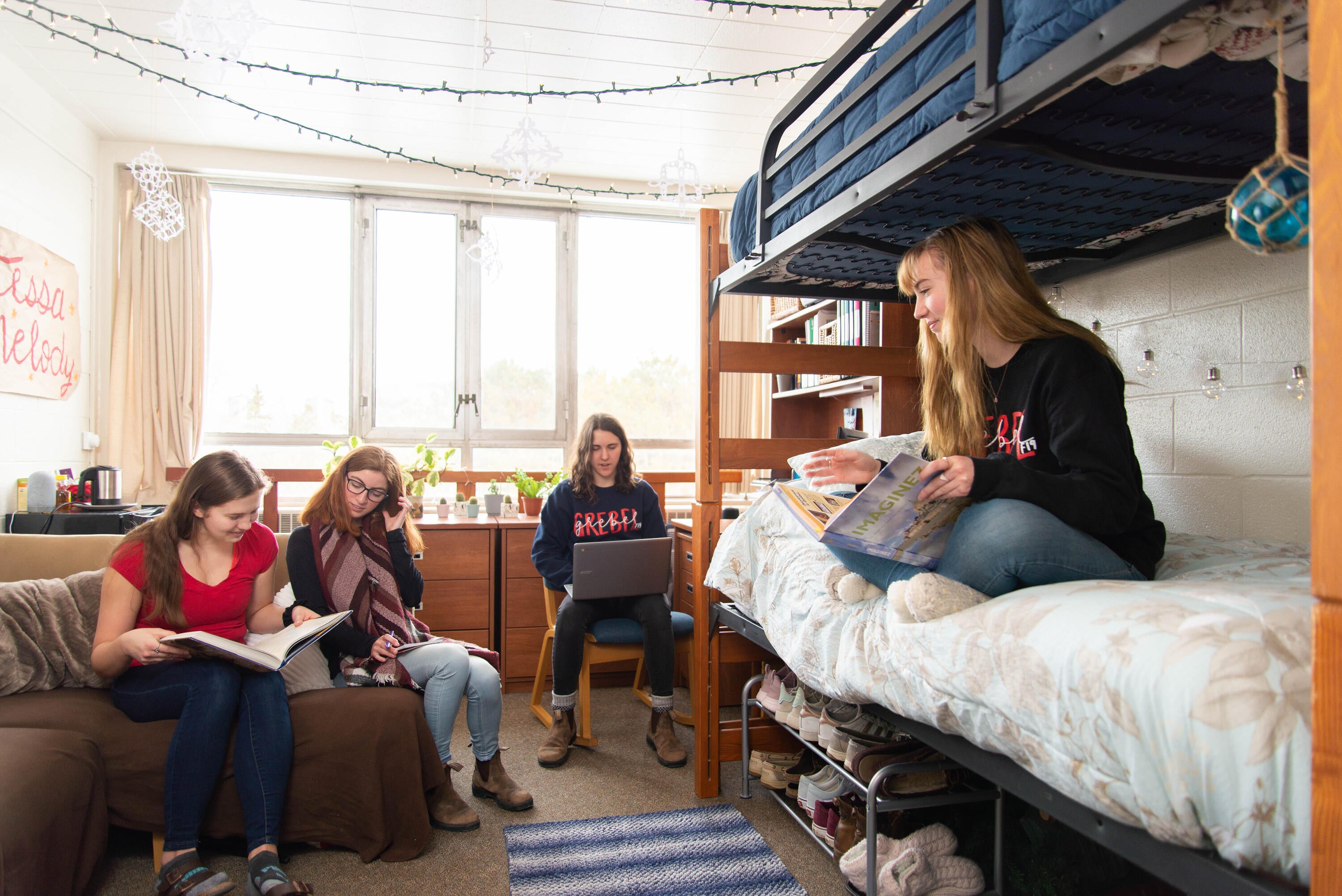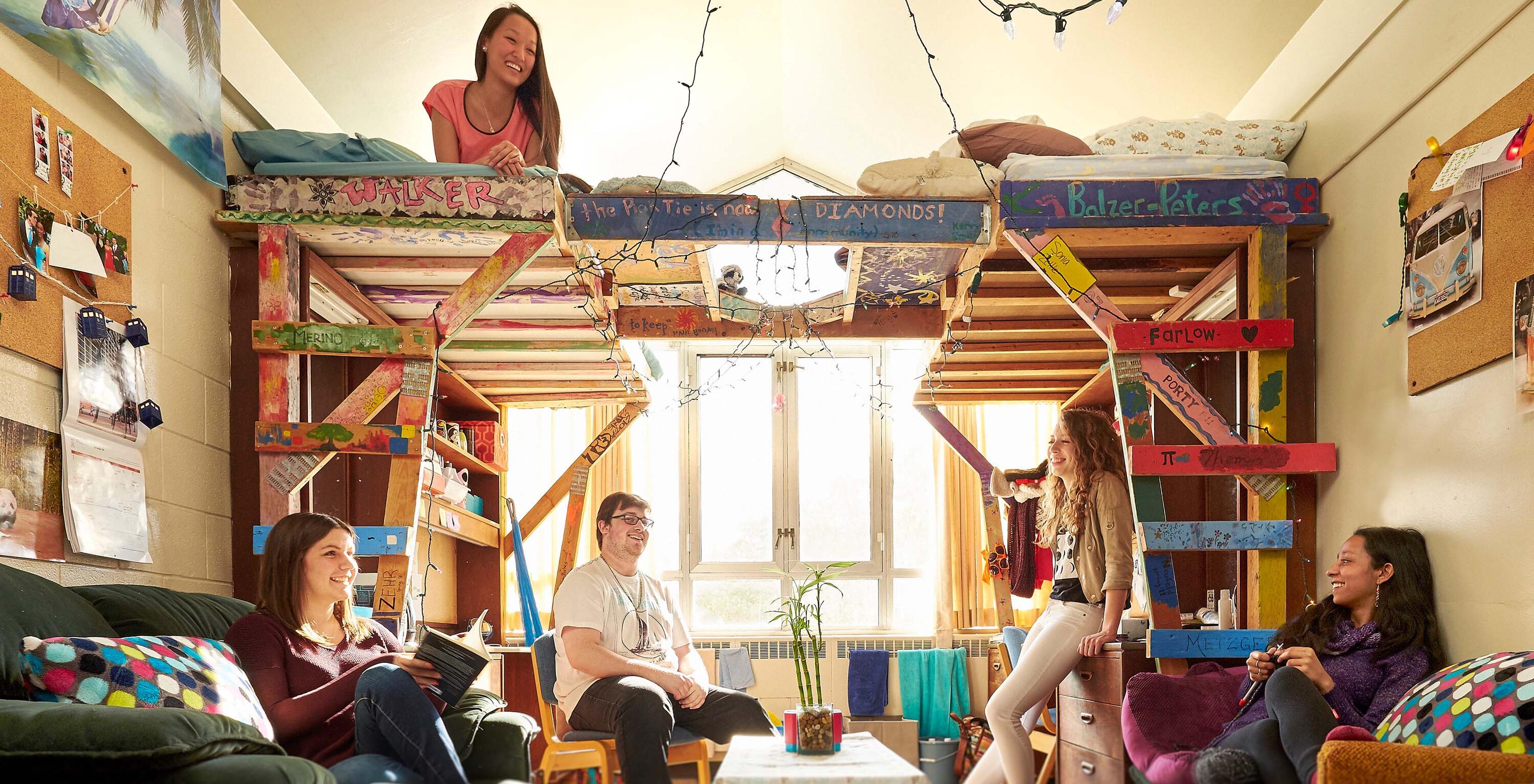
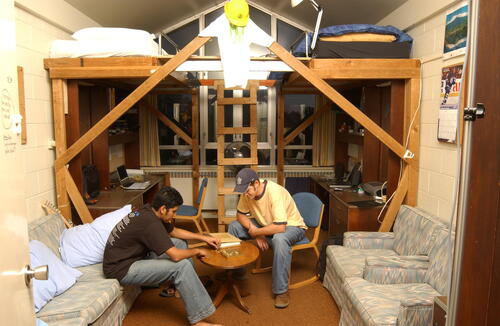
The famous skybunk can no longer be found in its original form in Grebel residence rooms. A recent furniture update has removed the need to build the unique structures because the College’s new modular furniture can be stacked in a number of much safer combinations. But memories of skybunks still abound among alumni who lived at Grebel during the golden era of the skybunk, and the homemade bunks will not be soon forgotten.
Skybunks were structures designed to lift beds off of the ground to create more space for couches, fridges, stereos, and other residence room additions. The goal was create the optimal hang out space in the name of building community in the Grebel residence.
The exact origins of the lifted beds are hard to trace. Dorothy Willms (BSC ‘81) and Jim Bender (OD ‘81) cite Bruce Breckbill (BA ‘85) and Richard Neff (BA ‘81) as the first creators of the skybunk back in the late 1970s, though the structures wouldn’t be christened “skybunks” until over a decade later. Rumour has it that these bunks were like a second floor loft that stretched over the entire room. Some called it “Ralph’s Bar and Grill,” but any photographic evidence of this loft’s existence has been lost to the ages.
Paul Penner, who has worked in Operations at Grebel since 1988, remembers some unfortunate incidents that could be blamed on skybunks. He has memories of students falling out of bunks without rails and breaking bones, and one student putting their foot through the window during a particularly restless sleep.

Skybunks were banned in the 80s due to student injuries and damage done to the residence building. But Paul Heidebrecht (BASC ‘94), now Director of the Kindred Credit Union Centre for Peace Advancement, came to Grebel as a student in 1989 and wanted to revive the structures. As a mechanical engineering student, Paul used his knowledge to convince Paul Penner that skybunks could be made safely and without causing damage to the building.
Paul recalls conversations with Penner that led to plans for freestanding structures to lift beds off of the ground without resting on the existing Grebel furniture. Then in the Spring of 1990, Paul and his roommate Terry Noble (BA ‘92) put their plan into action. In addition to being freestanding, the innovation that Paul and Terry contributed to the skybunk was to put the beds above their desks. This created space for more furniture and whatever else would make their room the perfect place to hang out. “We wanted our room to be the social room,” Paul explained. “There was a competitive aspect to building community,” he remarked, noting that he and Noble really wanted to live into Grebel’s open door policy.
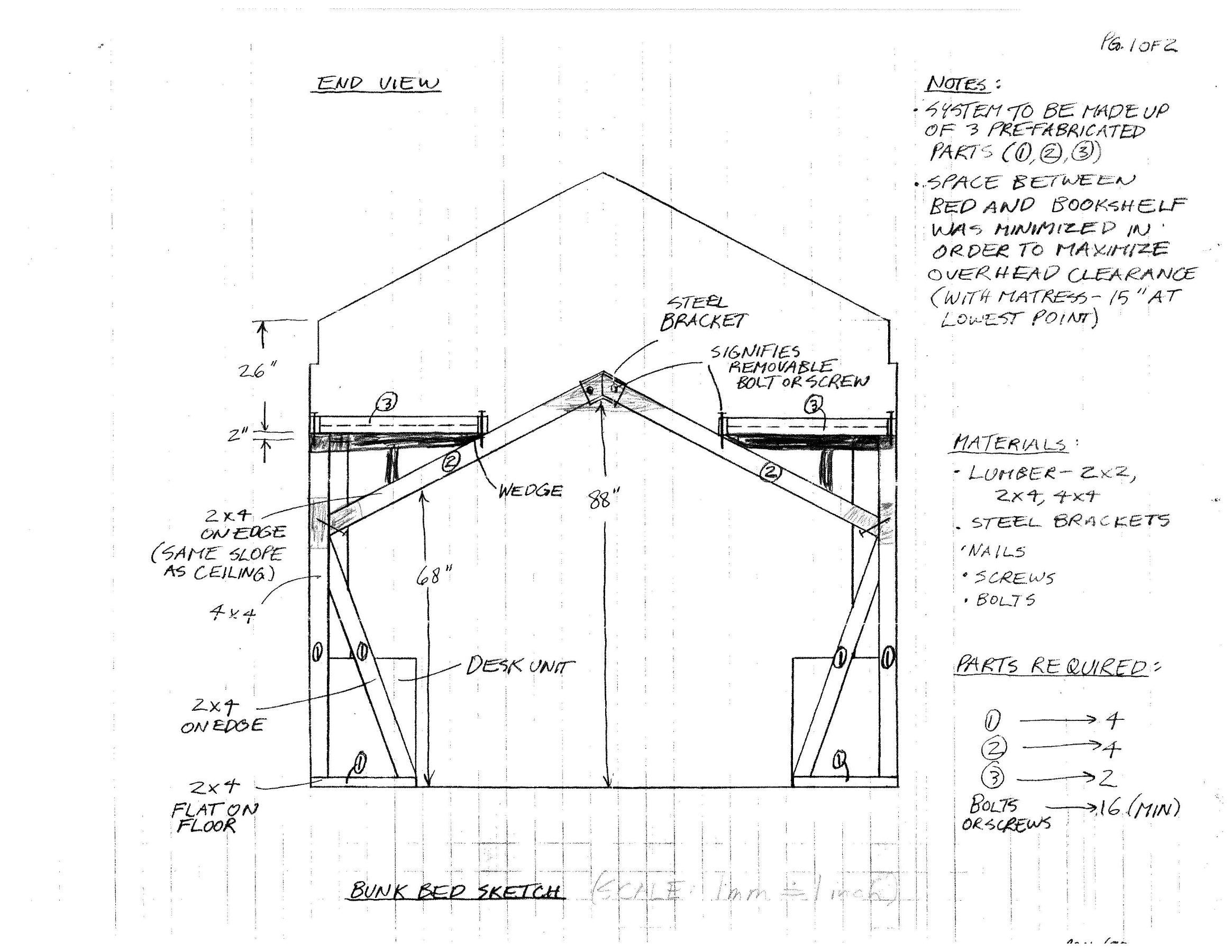
A architectural drawing of the original Skybunks, provided by Paul Heidebrecht
The popularity of skybunks exploded that spring, though the term “skybunk” originally only referred to the pair that Paul and Terry had built. Paul explained that the name came from the height of the raised beds, but also cited that the SkyDome, now known as the Rogers Centre, opened the previous year.
As time went on, “skybunk” came to refer to all raised beds. And innovations were introduced all along the way. Paul recalls that he and Noble originally climbed into their skybunks using rope ladders, then simply climbed the frames of the bunks when the rope ladders didn’t prove to be ideal. Later students would add sturdier ladders for climbing. Skybunks also came to feature more dependable railings than those that Paul and Noble had. Paul Penner remembers “arches of plants growing between the bunks” made using a lattice structure, and an intricate set of skybunks made from wrought iron.
From 2003 to 2018, the residence furniture was gradually replaced after decades of use. The versatility of this new furniture removed the need for skybunks. Though the dissolution of this Grebel-specific invention is sad for many, it’s better for the overall community. Students are safer, and every student can have a lifted bed, rather than only those who inherit a set of skybunks or build their own.
By Katrina Steckle
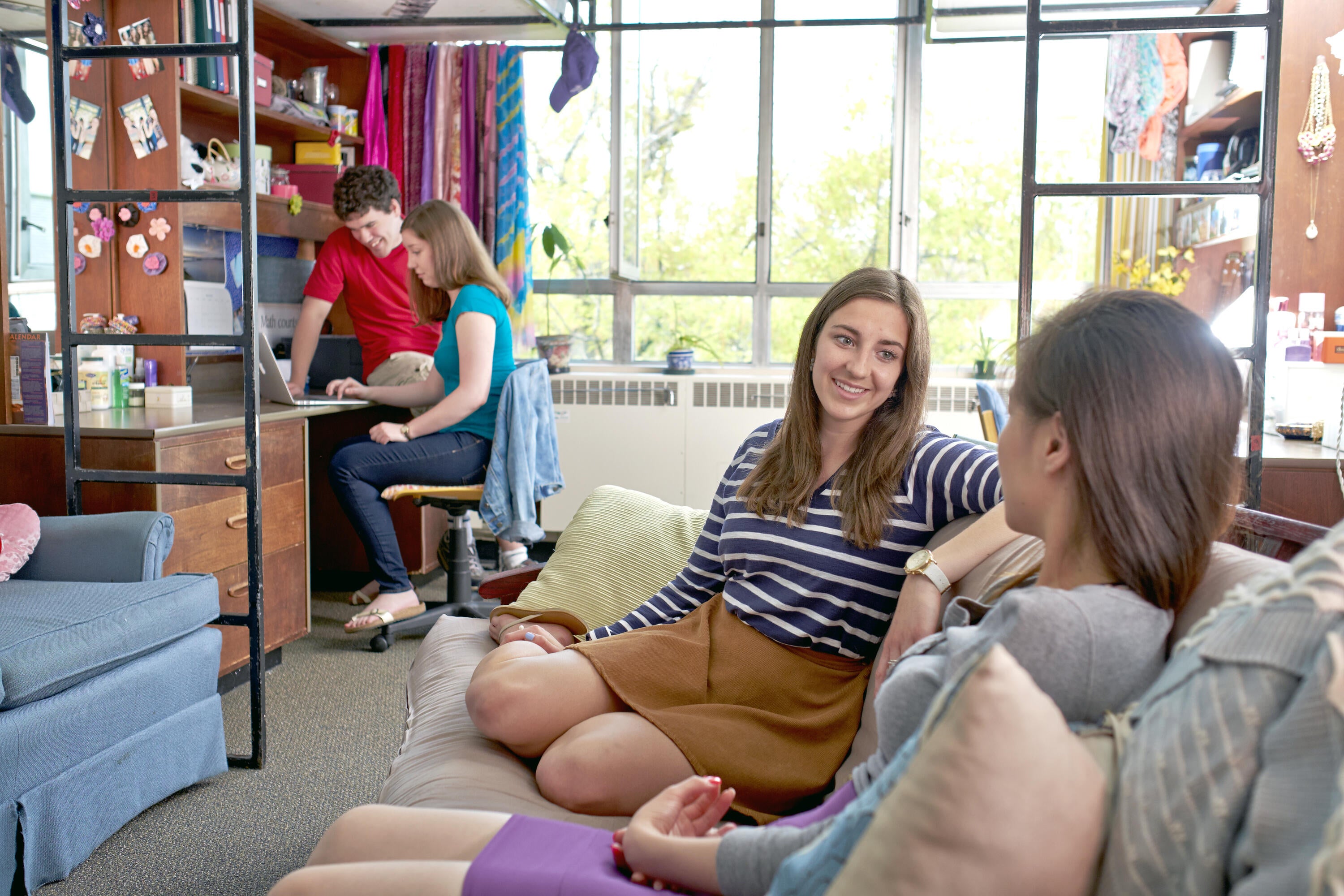
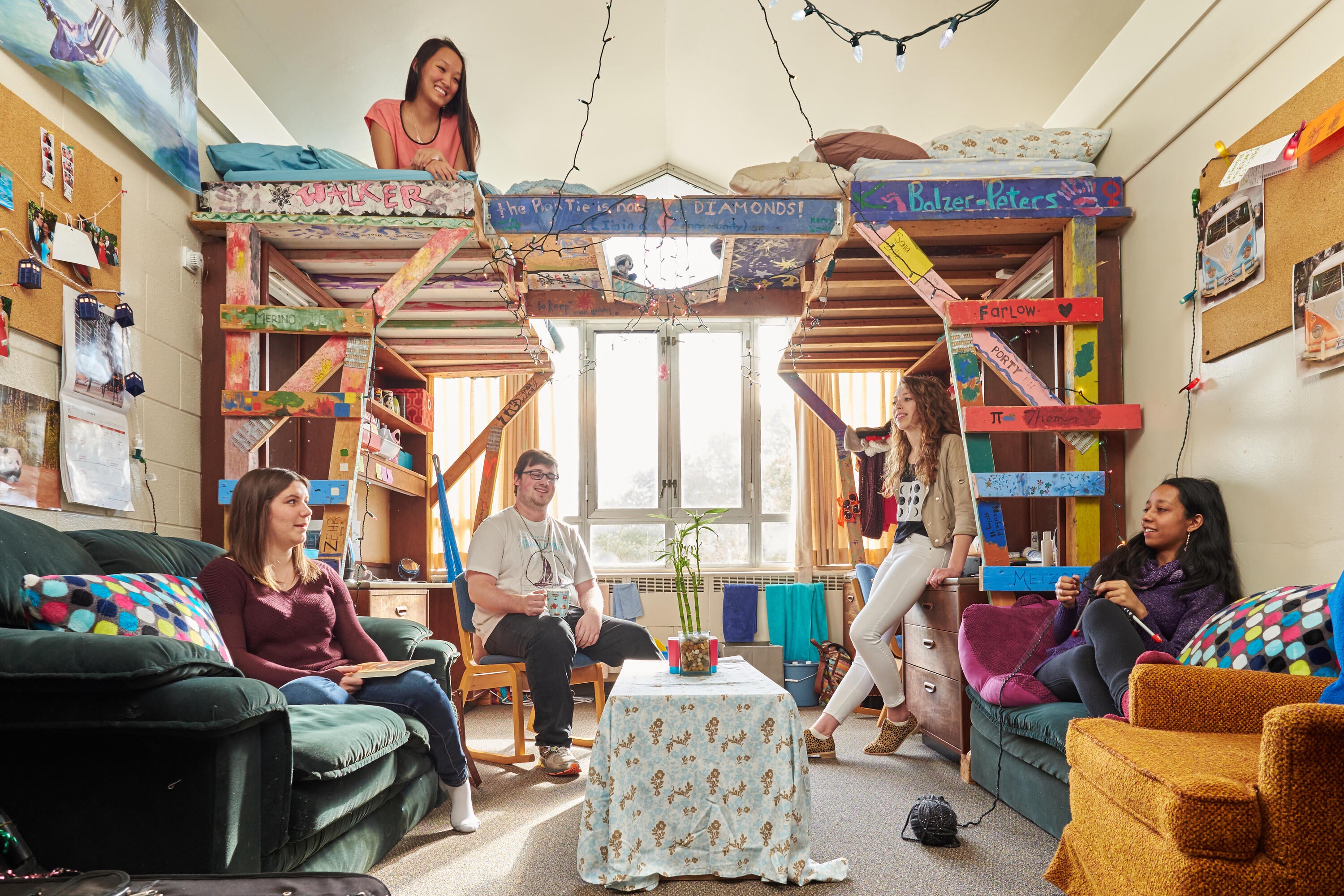
Alumni Skybunk Memories
Rachel Urban Shipley
My roommate and I somehow inherited a set that had only one ladder—and our sleep schedules were offset by two hours. We got very attuned to each others’ movement so usually either she would wake up when I came in at night or I would wake up when she got up in the morning (though she definitely climbed down the frame occasionally).
Emily Schaming
My roommate and I were set to inherit a set of skybunks. She decided to test their sturdiness and swung from them, and they promptly fell apart. Apparently they’d been held together with drywall screws!
Marika Helena
Cindy Hoskin and I had skybunks in a summer term. So much fun and lots of room to hang out! It was a must to get a couch to replace where your bed used to be and create an optimal hangout space.
Patrick Quealy
I had skybunks with Douglas Friesen during the Great Canadian Grebel summer of 1999. I loved the extra space, couch and layout the bunks gave us but hated the ladder and shaky nature of the bunks so I slept on the couch after the 3rd day of term.
Marty Barons
Someone’s room in Fall 2001 had a complete second floor with a TV above the closets and where the beds would have been on the floor, with a pole to get down. It had to be taken down.
Kirk Schmidt
Someone asked me to see if their skybunks were stable. So I stood in the room while she climbed up and started shaking them. Then the entire structure, including the two under-bed platforms started falling TOWARD me. I caught the structure and was holding it up, but one of the under-bed pieces came crashing down. Pretty much every person who had not left for break yet came running to the room. No, the structure was not stable... but everyone was okay.
Amy Langeman
When I lived in the short end, we borrowed a set. Daniel Fernandes was helping us set them up as our parents looked on. The bunks were pretty shaky and Fernandes crammed pizza boxes in as shims...Whenever the bunks got wiggly we just crammed more pizza boxes in!
Karsten Cheng
Jeremy Reesor and I loved our skybunks, though we accidently put the bunks up with the window open...so we had to take it down, close the window and put it back up.
Rebecca Osborne
Our dads came to build skybunks on a hot day. When we tried to close our windows that night, we realized the skybunks were built right against the open windows and would have to be disassembled to close the windows. All we had was a tiny screwdriver.
Tim Bemmann
Skybunks were awesome! It gave us room for couches to hang with friends, play games, and eat pizza. Also I loved to post exam study notes on the ceiling to review.
Mathieu Cain
By summer 2002, our regular wood skybunks had been passed down several times. They lasted until literally the last day of term when they suddenly collapsed, and so ended its life.
Nate Gundy
I had skybunks three of my four terms in the dorms (00-02). Definitely all hand-me-downs. Surprisingly, I didn’t have any structural issues, though I do remember them being a bit awkward to climb into. Totally worth it for all of the space they freed up!
Reuben Janzen-Martin
Skybunks were an excellent engineering challenge! Ron Roth and I reviewed the designs of many of the existing sky bunks during our first term at Grebel. We eventually designed and built our own, with the intent of remedying some of the shortcomings we saw with others. (Like not being able to open the windows, lack of ladders, and most importantly - structural stability.) It was also important that the angle of the main truss point match the angle of the ceiling slope.
The new modular furniture, allows for students to organize their room freely, and safely. (Photo from 2019)
